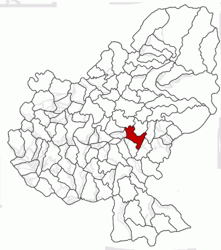Miercurea Nirajului
Miercurea Nirajului
Nyárádszereda | |
|---|---|
 The statue of István Bocskay | |
 Location in Mureș County | |
| Coordinates: 46°31′48″N 24°48′0″E / 46.53000°N 24.80000°E | |
| Country | Romania |
| County | Mureș |
| Government | |
| • Mayor | Sándor Toth[1] (UDMR) |
| Area | 55.88 km2 (21.58 sq mi) |
| Population (2021-12-01)[2] | 5,414 |
| • Density | 97/km2 (250/sq mi) |
| Time zone | EET/EEST (UTC+2/+3) |
| Vehicle reg. | MS |
| Website | www |
Miercurea Nirajului (Hungarian: Nyárádszereda [ˈɲaːraːt.sɛrɛdɒ]) is a town in Mureș County, Romania. It lies in the Székely Land, an ethno-cultural region in eastern Transylvania.
The following seven villages are administered by the town:
- Beu / Székelybő
- Dumitreștii / Demeterfalva
- Laureni / Kisszentlőrinc
- Moșuni / Székelymoson
- Șardu Nirajului / Székelysárd
- Tâmpa / Székelytompa
- Veța / Vece
History
The town is part of the Székely Land region of the historical Transylvania province. Its first written mention is from 1493 as Oppidum Zereda. István Bocskay was elected here as prince of Transylvania in 1604.
Until 1918, the town belonged to the Maros-Torda County of the Kingdom of Hungary. After the Hungarian–Romanian War of 1918–19 and the Treaty of Trianon of 1920, it became part of Romania.
Demographics
| Year | Pop. | ±% |
|---|---|---|
| 2002 | 5,824 | — |
| 2011 | 5,554 | −4.6% |
| Source: Census data | ||
The commune has a Székely Hungarian majority. According to the 2011 census, it has a population of 5,554 of which 83.3% are Hungarian, 10.4% Romanians, and 6.3% Roma.[3]
References
- ^ "Results of the 2016 local elections". Central Electoral Bureau. Retrieved 5 April 2020.
- ^ "Populaţia rezidentă după grupa de vârstă, pe județe și municipii, orașe, comune, la 1 decembrie 2021" (XLS). National Institute of Statistics.
- ^ (in Romanian) Populația stabilă după etnie - județe, municipii, orașe, comune, National Institute of Statistics; accessed August 26, 2015



